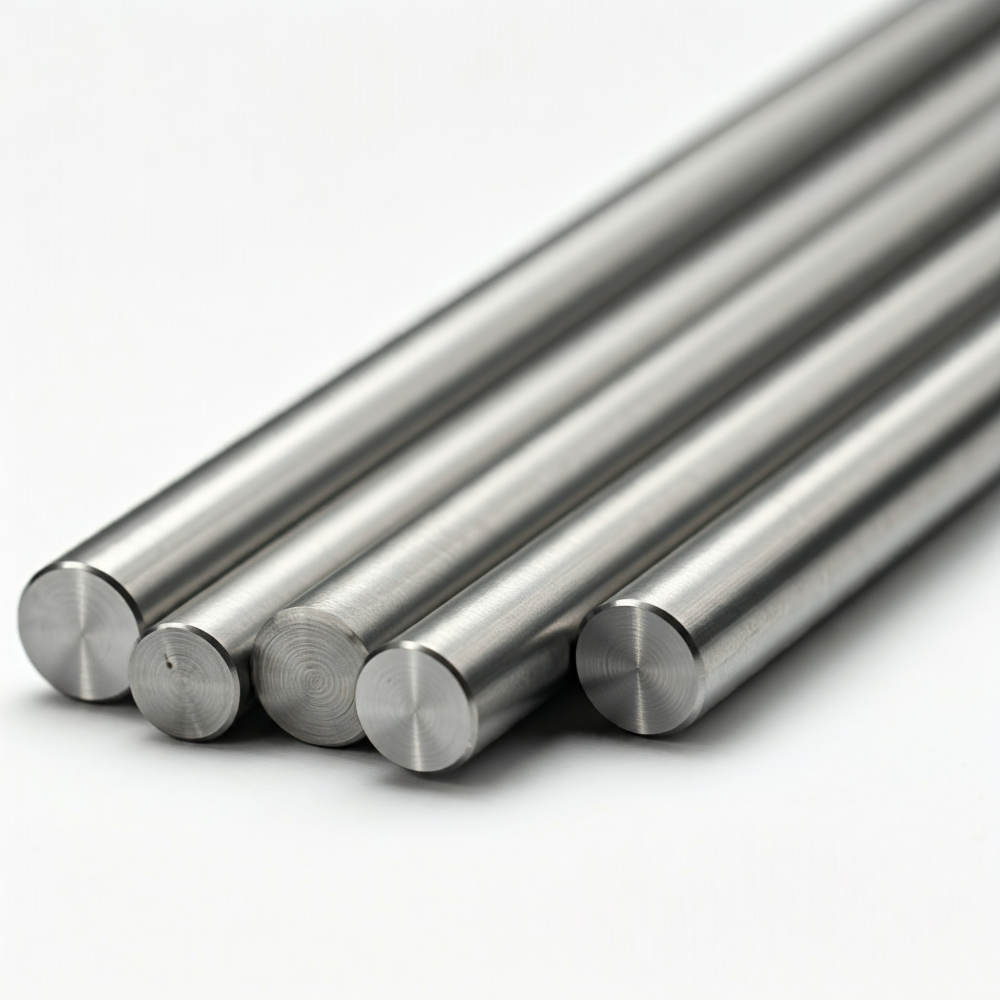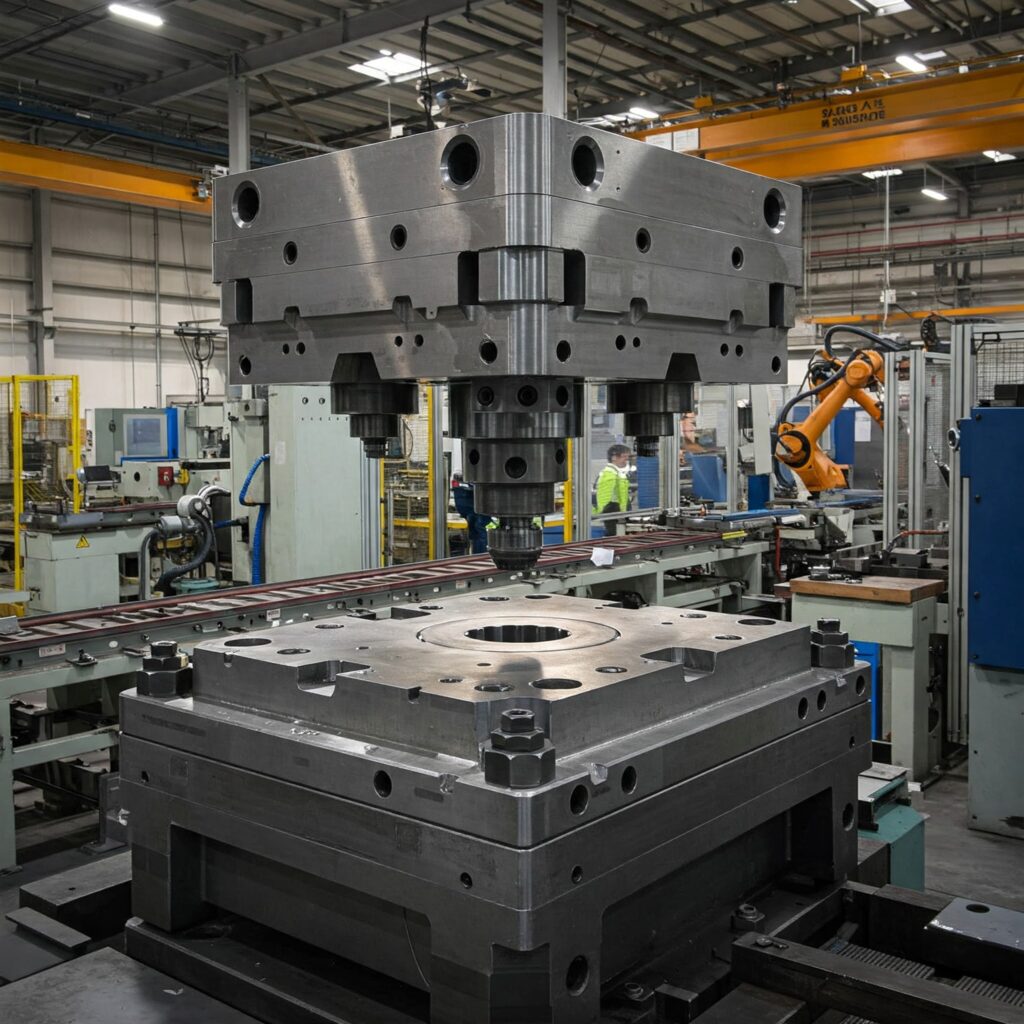Szacowany czas czytania: 15 minut
Najważniejsze wnioski
- Air-hardening steel is crucial in tool steel due to its low distortion during heat treatment and excellent mechanical properties.
- H13 tool steel is a prominent air-hardening steel used for molds operating under extreme conditions.
- Air-hardening steels use air cooling for hardening, minimizing deformation compared to water or oil quenching.
- Key benefits of H13 include high wear resistance, thermal stability, and outstanding resistance to thermal fatigue.
- Correct multi-stage heat treatment is essential to maximize the performance of H13 tool steel.
Spis treści
- The Role and Classification of Tool Steels in Industry
- The Metallurgy and Mechanics of Air Hardening
- Focus on H13: The Premier 5% Chromium Hot-Work Steel
- Essential Properties of H13 Tool Steel
- Heat Treatment: Achieving Optimal H13 Performance
- Applications of Air-Hardening Tool Steels
- Wniosek
- Często zadawane pytania
- Powiązane linki
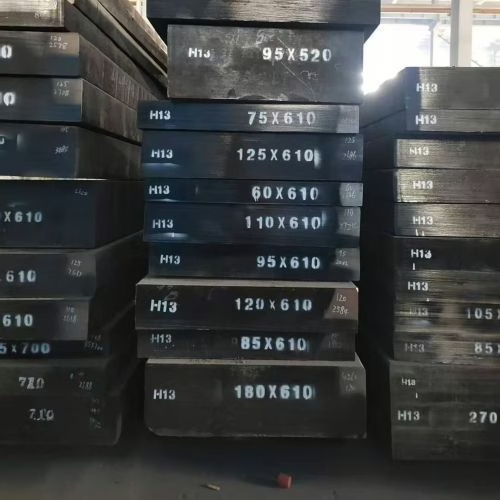
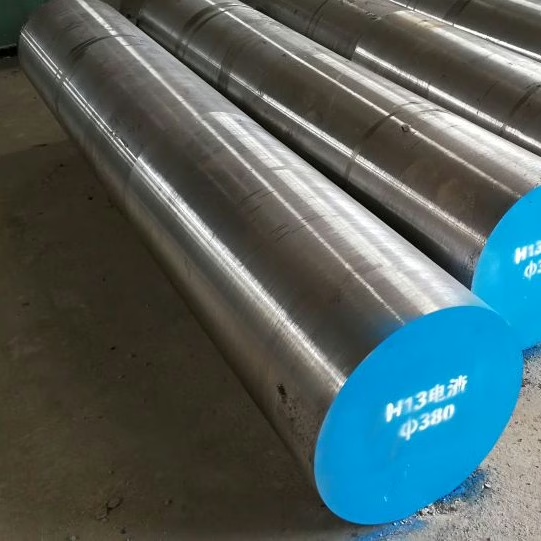
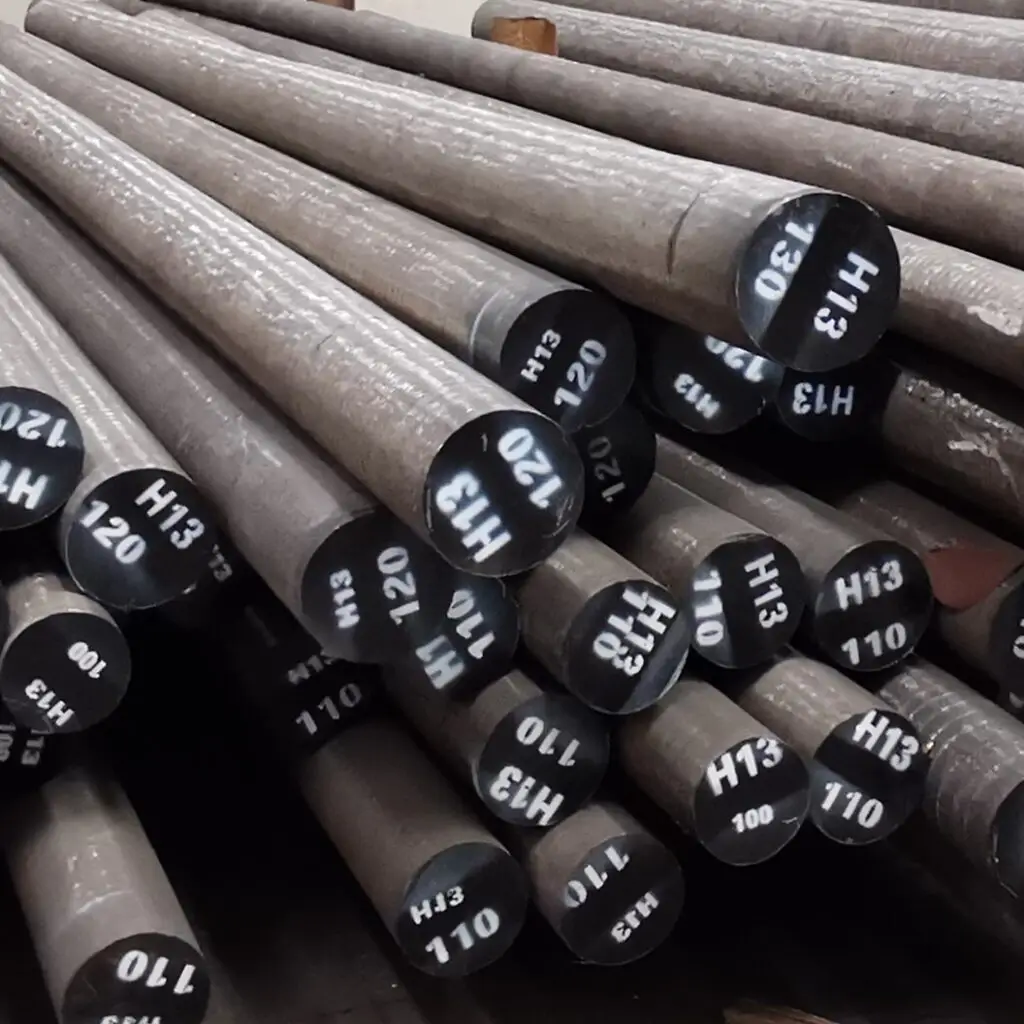
Air-hardening steel is a critically important category of tool steel in materials engineering. Its widespread application stems from its minimal distortion during heat treatment, excellent deep hardenability, and superior mechanical properties.
Air-hardening steels, such as the A and H series, rely on air-cooling—a relatively mild method—to achieve a hard martensitic structure. This stands in stark contrast to other steels requiring immersion in oil or water for vigorous quenching, which carry a higher risk of deformation or even cracking during rapid cooling.
Among the numerous air-hardening steels, AISI Stal narzędziowa H13 stands as one of the most widely used representatives. It is a hot-work tool steel containing approximately 5% chromium.
H13 tool steel is extensively used in the manufacture of molds that must operate under harsh conditions involving high temperatures, high pressures, and repeated thermal cycling. It is an ideal choice for die-casting molds, hot extrusion dies, and forging dies.
The Role and Classification of Tool Steels in Industry
Tool steels are a class of advanced alloys specifically engineered for manufacturing tools, dies, and molds. These molds form the foundation of industrial production, used to cut, shape, form, and punch various materials, including ferrous metals, non-ferrous metals, plastics, and even ceramics.
Because tool steels typically operate in extremely demanding environments, their production processes—such as electric furnace smelting or electroslag refining—must be strictly controlled to ensure the high quality and high purity required for high-demand service conditions.
A common defining characteristic of all tool steels is that their mechanical properties can be significantly enhanced through heat treatment.
To systematically manage the wide variety of tool steels, the American Iron and Steel Institute (AISI) developed a classification system. This system groups and designates these materials based on three primary criteria, assigning a classification letter such as H, A, D, etc.
| Group Identifying Symbol | Opis | Quenching Medium Reference |
| H | Stale narzędziowe do pracy na gorąco (Chromium, Tungsten, Molybdenum types) | Air (mostly), Oil, or Salt |
| A | Utwardzanie na powietrzu, stop średni Stale narzędziowe do pracy na zimno | Powietrze |
| D | High-Carbon, High-Chromium Cold Work Tool Steels | Air (D2, D4) or Oil (D3) |
| O | Oil-Hardening Cold Work Tool Steels | Olej |
| W | Water-Hardening Tool Steels | Water or Brine |
| S | Shock-Resisting Tool Steels | Water or Oil/Air |
| M & T | Molybdenum and Tungsten High-Speed Tool Steels | Air, Gas, Oil, or Salt Bath |
Air-hardening steels typically belong to Groups A, D, and H in the American Iron and Steel Institute (AISI) classification. Their defining characteristic is their sufficient carbon and alloy content, such as chromium, molybdenum, and manganese. This high alloy content confers exceptional hardenability, enabling the steel to achieve full hardening simply by cooling in still indoor air or with slow airflow after austenitizing.
This slow cooling process offers two critical advantages: First, dimensional changes and distortion (low movement) during heat treatment are minimized. Second, compared to aggressive water or oil quenching, air cooling significantly reduces the quenching stresses generated within the workpiece, thereby greatly mitigating the risk of cracking during the hardening process.
The Metallurgy and Mechanics of Air Hardening
Hardenability and the Role of Alloying Elements
Hardenability defines a steel’s capacity to achieve hardness penetration during heat treatment. Tool steels typically require high hardenability. The metallurgical principle behind air-hardening steel’s ability to harden upon cooling in air lies in its high content of alloying elements.
These alloying elements—such as chromium, molybdenum, manganese, and vanadium—primarily function to delay the microstructural transformation of steel at elevated temperatures (in the austenitic state). This delaying effect enables the steel, even during slow cooling in air, to bypass the formation of pearlite and bainite (both softer microstructures), thereby ensuring its ultimate transformation into hard martensite.
Specifically, the roles of several key alloying elements are as follows:
- Chromium (Cr), Molybdenum (Mo), and Vanadium (V): These are strong carbide-forming elements that effectively delay the austenite transformation and maintain microstructural stability in steel at elevated temperatures, i.e., resist high-temperature softening.
- Manganese (Mn) and Molybdenum (Mo): These elements are crucial for imparting “air-hardening” capability and high hardenability to steel, particularly evident in A-series steels.
- Nickel (Ni): Also promotes deep hardenability and enhances material toughness.
This high hardenability enables the steel to harden huge cross-sections. For example:
- A-series steels (e.g., Stal narzędziowa A2): Under air-cooling conditions, they can achieve complete hardening in bars up to 100 mm (4 inches) in diameter.
- H-series hot-work steels (e.g., H11, H12, H13): These exhibit superior hardenability, enabling complete working hardening in sections up to 150 mm (6 inches) in diameter. H13 exhibits particularly outstanding hardenability, capable of achieving complete quenching from surface to core even in massive 330 mm (13-inch) diameter bars under air cooling.
Minimizing Distortion and Stress
The most significant benefit of air quenching is dimensional stability. In contrast with rapid quenching (such as water quenching), the problem is that when steel is cooled rapidly, the transformation from austenite to martensite occurs extremely quickly, a process accompanied by volumetric expansion. This rapid and uneven expansion induces significant internal stresses within the workpiece, which is precisely the root cause of deformation, distortion, and even cracking.
By employing slow air cooling, the internal strain in the steel is significantly reduced. This results in greatly diminished deformation and minimizes movement of the workpiece during the hardening process.
Therefore, deeply hardenable steels such as Group A (air-hardening cold-work steels) and Group D (high-carbon, high-chromium steels) offer unparalleled advantages in terms of heat treatment safety and reduced deformation.
Focus on H13: The Premier 5% Chromium Hot-Work Steel
H13 (with AISI designation T20813 and DIN designation 1.2344) is currently the most widely used general-purpose hot-work tool steel internationally. It belongs to the chromium-based H series of hot-work steels (H1-H19). Within the industry, H13 is also commonly referred to by its nominal composition as 4Cr5MoSiV1, where the leading “4” indicates a carbon content of approximately 0.4%.
Skład chemiczny
The chemical formulation of H13 is specifically engineered to meet the demands of high-temperature working environments. Its precise composition enables it to deliver three critical properties essential for hot-work dies: high toughness, thermal stability (including thermal hardness), and wear resistance.
The following are its key chemical elements and their specific functions:
- Carbon (C): 0.32–0.45% H13 employs a medium carbon content, which ensures the material’s high toughness. This is achieved by limiting the carbon saturation of the martensitic structure and controlling the size of alloy carbide particles, thereby preventing excessive brittleness in the steel.
- Chromium (Cr): 4.75–5.50% Approximately 5% chromium content forms the foundation of H13’s performance. It primarily provides excellent deep hardenability and oxidation resistance. Simultaneously, it imparts the steel with good tempering resistance, which is essential for H13 to maintain hardness at elevated temperatures (heat hardness).
- Molybdenum (Mo): 1.10–1.75% Molybdenum is critical to the high-temperature performance of H13 tool steel. Its primary contribution is a significant increase in the steel’s thermal hardness—that is, its ability to resist softening during high-temperature operation.
- Vanadium (V): 0.80–1.20% H13 possesses a relatively high vanadium content (higher than H11). High vanadium is key to achieving high wear resistance, as it forms a large number of finely dispersed, extremely hard vanadium carbide particles within the steel, thereby endowing the die with outstanding wear resistance.
Manufacturing and Quality
Standard H13 steel exhibits excellent properties, but to meet the demands of high-performance applications—such as precision plastic injection molds or demanding die-casting molds—more advanced manufacturing processes are required.
These high-end applications demand steel with exceptional purity and microstructural uniformity. To achieve this, H13 steel typically requires production through advanced secondary refining (purification) techniques, primarily including: Electro-Slag Remelting (ESR) and Vacuum Arc Remelting (VAR).
The purpose of employing these advanced processes is to ensure H13 steel meets the following key quality standards: First, eliminate minute impurities and nonmetallic inclusions within the steel; Second, significantly reduce the content of harmful gases such as hydrogen and oxygen; Third, ensure consistent microstructure throughout the steel from the interior to the exterior, free from segregation.
Among these, H13 steel refined through the ESR (Przetapianie elektrożużlowe) process is particularly suitable for precision molds requiring both high hardness after heat treatment and high polishability (mirror finish) on the mold surface, owing to its exceptional purity.
In summary, high-quality H13 steel (such as certain refined grades) must possess high purity, uniform microstructure, and isotropic properties (meaning consistent mechanical performance in all directions), all of which depend on advanced manufacturing techniques like ESR or VAR.
Essential Properties of H13 Tool Steel
H13’s exceptional performance in demanding hot-working environments stems from a combination of multiple key characteristics, all of which require activation and management through precise heat treatment processes.
Hot Hardness and Temper Resistance (Secondary Hardening)
H13 exhibits excellent hot hardness, also known as “red hardness.” This refers to the material’s ability to maintain hardness and resist softening at elevated temperatures (e.g., above 205°C/400°F).
H13 is a secondary-hardening steel. This property stems from its unique tempering reaction.
When H13 steel is tempered at extremely high temperatures, typically between 500°C and 600°C, a large quantity of extremely fine and uniformly distributed alloy carbides (primarily molybdenum-Mo and vanadium-V carbides) precipitates within the steel. The precipitation of these carbides paradoxically causes the steel’s hardness to rise again at elevated temperatures. The hardness peak (typically reached during tempering at approximately 510°C / 950°F) may even exceed the hardness immediately after quenching.
It is precisely this “secondary hardening” mechanism that enables H13 to maintain exceptionally high hardness and strength without softening, even under prolonged exposure in operating environments up to 540°C (1000°F).
High Toughness and Resistance to Heat Checking
High Toughness is the core property enabling hot-work dies to withstand impact loads and prevent catastrophic fracture. H13’s high toughness stems from its low carbon content, maintained at around 0.40%. This is because while higher carbon content increases hardness, it typically leads to reduced toughness. Through this balance, H13 achieves outstanding impact resistance while maintaining high strength.
Heat checking is one of the most common mold failure modes in hot-working applications such as die casting. It manifests as a network of fine cracks on the mold surface caused by thermal fatigue. This fatigue results from the mold repeatedly enduring immense stresses during rapid heating and rapid cooling cycles throughout operation.
H13, as a chromium-based hot-work steel, exhibits exceptional resistance to thermal shock, thereby demonstrating outstanding resistance to hot cracking. This makes it the material of choice for hot-work processes requiring cooling through contact with water or other media, such as die casting.
Wear Resistance and Surface Modification
H13 offers excellent resistance to abrasive wear. This wear resistance is primarily attributed to the vanadium (V) element in its composition, which forms hard vanadium carbides within the steel. H13 has lower carbon content and total carbide volume compared to cold-work steels like Stal narzędziowa D2. This represents a performance trade-off. H13 is designed to prioritize toughness rather than pursuing extreme wear resistance like cold-work steels.
When applications require H13 steel to exhibit enhanced surface wear resistance, its performance can be significantly improved through surface modification processes, with nitriding being the most commonly employed technique.
H13 is exceptionally well-suited for nitriding treatment. Thanks to its strong tempering resistance (the “heat hardness” mentioned earlier), H13 can undergo processing at the high temperatures required for nitriding without softening its core hardness. The nitriding process works by introducing nitrogen (N) into the workpiece surface, forming an extremely hard case layer with hardness exceeding 70 HRC. This enables H13 to ultimately achieve an ideal combination of “hard on the outside, tough on the inside”: the surface exhibits exceptional wear resistance, while the core (typically maintained around 45 HRC) remains sufficiently tough to withstand impact. This combination is highly suitable for thermal wear applications such as forging and extrusion.
Heat Treatment: Achieving Optimal H13 Performance
Proper heat treatment Jest absolutely critical to the ultimate success or failure of H13 tool steel. Even the highest-quality H13 steel can be rendered completely ineffective if the heat treatment process is improperly executed.
The overall objective of H13 heat treatment is to transform its soft annealed microstructure—ferrite plus alloy carbides—into a hard, stable, carbide-reinforced tempered martensite microstructure.
This process primarily involves the following strict steps:
Annealing and Stress Relieving
This is the preparatory stage before final hardening.
Before hardening, H13 steel must first undergo proper annealing to soften the material and make it easier to machine. A typical annealing cycle involves heating the steel to 871°C (1600°F), holding it at this temperature for a duration based on material thickness (e.g., 1 hour per inch of thickness), then cooling it very slowly (e.g., 14°C/25°F per hour) to 482°C (900°F), and finally air-cooling it. Hardness after annealing is typically below 220 HB (Brinell hardness).
Following machining and before formal quenching, a stress-relief process is typically performed. This step eliminates plastic deformation and high surface stresses introduced during machining, as these stresses, if left unaddressed, can readily cause distortion or cracking during subsequent quenching heating.
Austenityzowanie i hartowanie
This is the core step in hardening steel. Austenitizing involves heating steel to a specific high temperature to dissolve complex alloy carbides within the steel and transform the microstructure into “austenite.” For H13 steel, the austenitizing temperature typically ranges between 1010°C (1850°F) and 1025°C (1875°F). Immediately following this, the high-temperature austenite must be quenched to transform it into a high-stress, high-hardness “martensite” structure. Due to H13’s extremely high hardenability, air cooling is the standard quenching medium. Cooling in still indoor air (or gas cooling) is the most gentle quenching method, minimizing thermal shock and internal stresses. After quenching, H13 steel must be cooled to at least 66°C (150°F) before proceeding to the subsequent tempering stage.
Tempering: Stress Relief and Property Optimization
Tempering is a step that must be performed immediately after quenching to optimize the final properties of steel. If delayed too long, the immense quenching stresses may cause the workpiece to crack spontaneously. The martensitic structure immediately after quenching is extremely hard, yet simultaneously highly stressed and brittle. The purpose of tempering is to eliminate internal stresses, significantly enhance toughness, and slightly adjust hardness.
For H13 and other high-alloy hot-work steels, multiple tempering is strongly recommended (typically two or three times). Multiple tempering eliminates retained austenite and improves microstructural stability. The working hardness of H13 after tempering is typically between 44 HRC and 54 HRC.
| Tempering Temperature (H13) | Corresponding Hardness (HRC) | Key Consideration |
| 980∘F (527∘C) | 52 | Provides high strength. |
| 1030∘F (555∘C) | 50 | Recommended working hardness for die casting (44−48 HRC). |
| 1100∘F (593∘C) | 46 | Recommended working hardness for shock resistance (40−44 HRC). |
Applications of Air-Hardening Tool Steels
Air-hardening tool steels are preferred for manufacturing workpieces with complex designs or large cross-sections due to their inherent strength, reliability, and especially their minimal deformation during heat treatment.
H13: Hot Work and Die Casting Dominance
H13 is the undisputed leader in hot-working applications, where molds must repeatedly withstand extreme temperatures, typically exceeding 600°C, and heavy loads.
The primary application segments for H13 are as follows:
- Die Casting Dies: This is the most widely used application for H13. It is employed for die casting zinc, aluminum, and magnesium alloys. H13 excels because it effectively resists corrosion from molten aluminum and possesses outstanding heat fatigue resistance (i.e., the ability to withstand “heat cracking” caused by repeated rapid thermal cycling). The recommended hardness for die casting dies is typically 44–48 HRC.
- Extrusion and Forging: H13 is extensively used in hot extrusion dies, forging dies, mandrels, and punches. These applications particularly demand exceptionally high toughness to withstand impact loads. Consequently, the recommended hardness range is slightly lower, typically 40–44 HRC, prioritizing optimal toughness.
- Molding: H13 is also a preferred steel for plastic injection molds. For precision molds requiring high polishability (mirror finish), such as automotive lens molds, the industry specifically specifies the use of high-purity H13 steel refined via ESR (Electroslag Remelting).
Other Air-Hardening Classes
The advantages of air hardening (low deformation) extend to cold work steels and high-speed steels:
- A-Series (Medium-Alloy Cold Work Steel) – A2
A2’s core advantage is minimal deformation during hardening, offering higher toughness than traditional oil-hardening steels with comparable or superior wear resistance. It is suitable for forming dies, blanking dies, and deep-drawing dies.
- D-Series (High-Carbon, High-Chromium Cold Work Steel) – D2
D2 is a high-performance air-hardening steel offering exceptional wear resistance and non-deforming properties. It is suitable for long-life, high-volume blanking, cold forming, and deep drawing operations. D2 also serves as the industry benchmark for measuring the “wear resistance” and “dimensional stability” of other steels.
- S-Series (Impact-Resistant Steel) – S7
Stal narzędziowa S7 is a versatile impact-resistant air-hardening steel with outstanding impact strength (i.e., high toughness). It is commonly used for medium-duty cold work tools, shear blades, and some medium-duty hot work dies.
- M & T Series (High-Speed Steel, HSS):
Many molybdenum-based (M series, e.g., M2, M4, M42) and tungsten-based (T series) high-speed steels are also air-hardening (or gas-quenchable). They rely on air cooling to achieve their extreme wear resistance and red hardness (i.e., the ability to maintain hardness under the high temperatures generated during cutting), making them core materials for manufacturing high-speed cutting tools.
Wniosek
H13 hot-work tool steel, a typical representative of air-hardening tool steels, achieves exceptional deep hardenability through the addition of high levels of carbide-forming elements such as chromium, molybdenum, and vanadium. This property enables controlled cooling in air. Compared to traditional liquid quenching (water quenching or oil quenching), this gentle air-cooling technology minimizes thermal stress and dimensional changes (deformation) caused by rapid cooling. This ultimately results in manufactured parts with highly stable geometry and minimal residual stress.
The three core advantages of H13 tool steel are high wear resistance, exceptional thermal stability, and outstanding resistance to thermal fatigue. These characteristics make H13 the absolute top choice for die casting molds and hot extrusion dies. However, to fully realize the potential of H13 tool steel, its excellent composition must be combined with the correct, multi-stage heat treatment process.
Często zadawane pytania
Air-hardening steel is a tool steel that contains sufficient carbon and alloying elements to fully harden (transform to martensite) simply by cooling in still room air or slow gaseous media from the austenitizing temperature. This slow cooling minimizes residual stress and distortion, promoting excellent dimensional stability during the hardening process.
Yes, A2 tool steel must be hardened to develop its optimum properties. A2 is a cold-work tool steel that is air-hardened; the process involves heating (austenitizing) followed by cooling in air (quenching) and subsequent tempering to achieve the necessary high hardness and wear resistance.
A2 tool steel is highly popular due to its high hardenability, minimal distortion in hardening, and good abrasion resistance, resulting from its content of carbon and 5% chromium. It is widely used for cold-work applications such as shear knives, punches, blanking and trimming dies, forming dies, and coining dies.
H13 is a Hot-Work Tool Steel designed for use at high temperatures (up to 700°C/1300°F) and combines good red hardness, abrasion resistance, and resistance to heat checking. S7 is a Shock-Resisting Tool Steel that is characterized by having the highest shock resistance rating among tool steels, possessing excellent impact strength and versatility for applications involving repetitive impact stresses. Both grades are air-hardening.
Yes, S7 is typically much harder than through-hardened 4140. S7 tool steel usually has a normal working hardness between 56–58 HRC, while through-hardened 4140 medium alloy steel typically achieves 36–42 HRC.
Yes, H13 is an air-hardening, chromium-based hot-work die steel. It has deep hardenability, meaning large sections, up to 12 inches (305 mm) in diameter, can be hardened fully by cooling in air.
Yes, S7 tool steel must be hardened and tempered to achieve its intended mechanical properties. S7 is an air-hardening, shock-resisting tool steel, typically air-quenched from 1725°F (941°C) and tempered to achieve a normal working hardness of 56–58 HRC.
While the sources do not specifically mention “BCG,” S7 tool steel is highly suitable for structural components subject to impact and shock loading. It has the highest shock-resistant rating of all tool steels, making it noted for resistance to chipping and applications involving impact stress. S7 also maintains good properties up to 1000°F (540°C).
Powiązane linki
Odblokuj wyższą wydajność dzięki naszej stali narzędziowej H13
W Aobo Steel wykorzystujemy ponad 20 lat doświadczenia w kuciu dostarczać najwyższej jakości stal narzędziową H13. Znana ze swojej wyjątkowej twardości na gorąco, wytrzymałości i odporności na zmęczenie cieplne, nasza H13 jest idealnym wyborem do najbardziej wymagających zastosowań, w tym odlewania ciśnieniowego, matryc do wytłaczania i narzędzi do kucia.
Współpracuj z zaufanym dostawcą, którego wspiera ponad 40 stabilnych źródeł materialnych. Uzyskaj stałą jakość i niezawodność, na których opierają się Twoje operacje.
Chcesz udoskonalić swoją produkcję dzięki najwyższej jakości H13?
Po prostu wypełnij poniższy formularz kontaktowy. Nasi specjaliści H13 skontaktują się z Tobą niezwłocznie, aby omówić Twoje wymagania i przedstawić spersonalizowaną wycenę.

